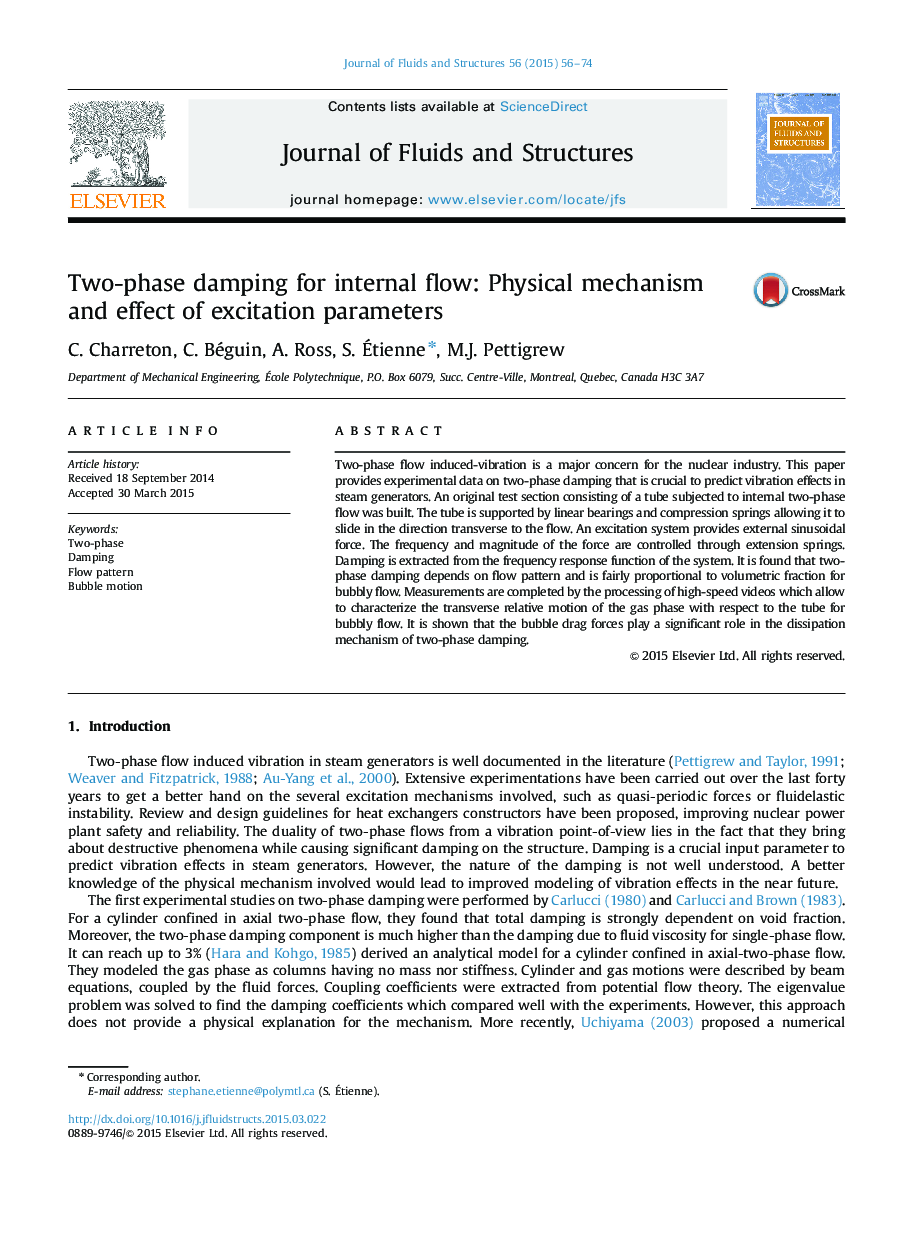| کد مقاله | کد نشریه | سال انتشار | مقاله انگلیسی | نسخه تمام متن |
|---|---|---|---|---|
| 7175945 | 1466591 | 2015 | 19 صفحه PDF | دانلود رایگان |
عنوان انگلیسی مقاله ISI
Two-phase damping for internal flow: Physical mechanism and effect of excitation parameters
ترجمه فارسی عنوان
خازن دو فاز برای جریان داخلی: مکانیزم فیزیکی و اثر پارامترهای تحریک
دانلود مقاله + سفارش ترجمه
دانلود مقاله ISI انگلیسی
رایگان برای ایرانیان
کلمات کلیدی
دو مرحله ای دمیدن، الگوی جریان، حرکت حباب،
ترجمه چکیده
جریان القایی جریان دو فاز یک نگرانی عمده برای صنعت هسته ای است. این مقاله داده های آزمایشی را در مورد تغییرات دو فاز ارائه می دهد که برای پیش بینی اثرات ارتعاش در ژنراتور بخار ضروری است. یک بخش آزمون اصلی شامل یک لوله تحت جریان دو فازی داخلی ساخته شد. لوله توسط بلبرینگ های خطی و چشمه های فشرده سازی پشتیبانی می شود که به آن می تواند در جهت پراکنده به جریان اسلاید. یک سیستم تحریک نیروی خارجی سینوسی فراهم می کند. فرکانس و بزرگی نیرو از طریق اسپرینگز فرمان کنترل می شود. لرزش از عملکرد پاسخ فرکانسی سیستم استخراج می شود. مشخص شده است که کاهش دو فاز بستگی به الگوی جریان دارد و نسبتا کسر حجمی برای جریان حباب نسبتا متناسب است. اندازه گیری توسط پردازش فیلم های با سرعت بالا تکمیل می شود که اجازه می دهد حرکت نسبی عرضی فاز گاز را با توجه به لوله برای جریان حباب مشخص کند. نشان داده شده است که نیروهای کشیدن حباب نقش مهمی در مکانیزم تخلیه دوام فاز دارند.
موضوعات مرتبط
مهندسی و علوم پایه
سایر رشته های مهندسی
مهندسی مکانیک
چکیده انگلیسی
Two-phase flow induced-vibration is a major concern for the nuclear industry. This paper provides experimental data on two-phase damping that is crucial to predict vibration effects in steam generators. An original test section consisting of a tube subjected to internal two-phase flow was built. The tube is supported by linear bearings and compression springs allowing it to slide in the direction transverse to the flow. An excitation system provides external sinusoidal force. The frequency and magnitude of the force are controlled through extension springs. Damping is extracted from the frequency response function of the system. It is found that two-phase damping depends on flow pattern and is fairly proportional to volumetric fraction for bubbly flow. Measurements are completed by the processing of high-speed videos which allow to characterize the transverse relative motion of the gas phase with respect to the tube for bubbly flow. It is shown that the bubble drag forces play a significant role in the dissipation mechanism of two-phase damping.
ناشر
Database: Elsevier - ScienceDirect (ساینس دایرکت)
Journal: Journal of Fluids and Structures - Volume 56, July 2015, Pages 56-74
Journal: Journal of Fluids and Structures - Volume 56, July 2015, Pages 56-74
نویسندگان
C. Charreton, C. Béguin, A. Ross, S. Ãtienne, M.J. Pettigrew,
